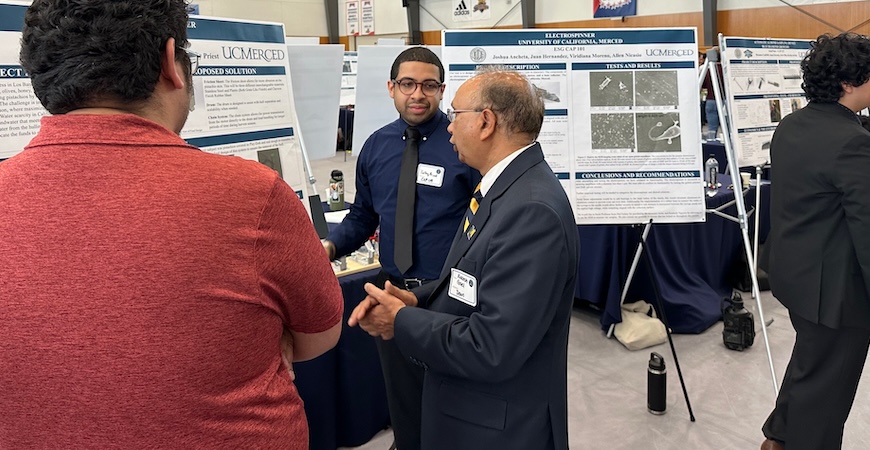
A translucent guide for needle placement to alleviate spinal pain. A collection system for urine to use as fertilizer. A system that attaches to the vents of a commuter train network to reduce the noise air makes when it is expelled. An artificial intelligence-powered chatbot to answer questions for website visitors and assist in event planning and organization.
These are some of the winning projects at UC Merced's spring 2024 Innovate to Grow, or I2G, program.
The School of Engineering's event held twice a year at the end of a semester, showcased dozens of projects. Teams of students worked with clients for months to solve real-world challenges they face, either by designing new products or by creating software.
Clients this year included the Bay Area Rapid Transit system, Lawrence Livermore National Lab, Central Valley farmers, and an Italian innovation and culture hub.
Student teams created posters describing their projects, which were displayed at an open session at UC Merced. Then they moved into individual presentations, where they discussed the process for their projects and demonstrated them for judges.
The winners are:
Engineering capstone
Devices: RadiantGuide Innovation
Team members: Aaliyah Ruiz-Corral, Brian Lu, Jenifer Hernandez Garcia, Jarmaine Roxas
Students worked with client Gabriel Garcia-Diaz, a spine orthopedic surgeon. Their project involved collecting measurements from spinal needles after insertion under fluoroscopic guidance to treat different pain and using the data to create a radiolucent (transparent under X-ray) guide for precise needle placement.
Precision: Urine Harvesters Collective
Team members: Karson Chu, Mark Kim, Nicholas Anggriani, Serjio Orozco-Rivera
This team worked for UmidaAg, an irrigation company based in Fresno that strives for crops that emit zero carbon. The team designed a collection system that can transport urine from portable and custom-made urinals into a storage system for accessibility. The system is intended for use by waste disposal companies at outdoor events and has the potential to reduce disposal cost and human waste pollution.
AgTech: Acousticops
Team members: Brinda Pandi, Elijah Lopez, Omar Estrada Marquez, Samuel Simoes
This team worked with BART to mitigate loud air exhaust along the commuter train lines while preserving optimal airflow. Their proposal entailed a practical construction solution atop the existing structure, incorporating sound-absorbing concrete engineered to diminish noise levels in alignment with predominant frequencies emitted at the site. The team also advocated for the deployment of acoustic louvers to supplement noise mitigation efforts without compromising airflow rates.
Lab: E.N.R.G. - Explosive Nozzle Removal Group - Powder explosivity nozzle removal
Team members: Christopher Navarro, Emmanuel Maldonado, Jason Estevez, Nicolas Nicosia
Working with the Lawrence Livermore National Lab, this team addressed the need for enhanced safety when removing components for cleaning and sanitation after metal powder reactivity testing. Members designed and built specialized tools capable of safely and efficiently removing each component of the explosive power nozzle used in testing procedures.
Food tech: AgriTech Innovation
Team members: Colby Priest, Isaias Teran, Justin Arroyo, Todd Miller
This team worked with client USA Produce, a family-owned business in Los Banos focused on producing flavored nuts, dehydrated fruits, teas, olives, honey, royal honey and garlic. The challenge was reducing water use for removing the skins from pistachio shells. AgriTech Innovation engineers came up with a design to remove the skin without using water, reducing the processing cost and maintaining the nuts' structural integrity.
Software Engineering Capstone
Ag Food: Clean-Up Crew Biosecurity Scheduling Algorithm Enhancement
Team members: Ariana Curtis, Jaime Gomez, Lauren Lane, Simone Romero
Working with Agrecom Inc., a biosecurity solutions company, this team developed a CP-SAT (Constraint Programing - Satisfiability) solving algorithm to automate schedule creation in a web application. This system generates optimized schedules by incorporating customer, job and employee data while prioritizing important jobs and managing recurring jobs. Completed schedules are automatically integrated with Microsoft Calendars, streamlining operations and enhancing efficiency.
Data: #include
Team members: Adam Bowen, Madeline Reiterman, Swapnil Kumar, Said Olguin
This team worked on the second phase of automating the purchasing process for the UC Merced School of Engineering, The team built on existing web app core features, including automatic saving of requests, updated data storage and documentation, an email notification system, dynamic account creation, and improved administrative control in team, roster and budget management.
Industry: Innovision
Team members: Ariana Quiroz-Alvarez, Claire Hallock, Jose Ruiz, Kianna Ng
This team worked with INNOVIT, an Italian innovation and culture hub, supported by the Italian Ministry of Foreign Affairs and managed by the Italian Consulate General in San Francisco and the Italian Embassy in Washington, D.C. INNOVIT sought the development of a customized AI chatbot to assist event planning and organization. The team developed a chatbot in Slack that has access to data such as mentors, workshop ideas and workshop schedules. The team also was asked to create a public-facing chatbot that would be incorporated into INNOVIT's website and could answer frequently asked questions by visitors.
Rakesh Goel, dean of the School of Engineering, visited with students during the opening session of I2G, asking about their projects and discussing their designs.
"It's an exciting time for our students," Goel said. "They are so smart. I always learn something when I come here."

